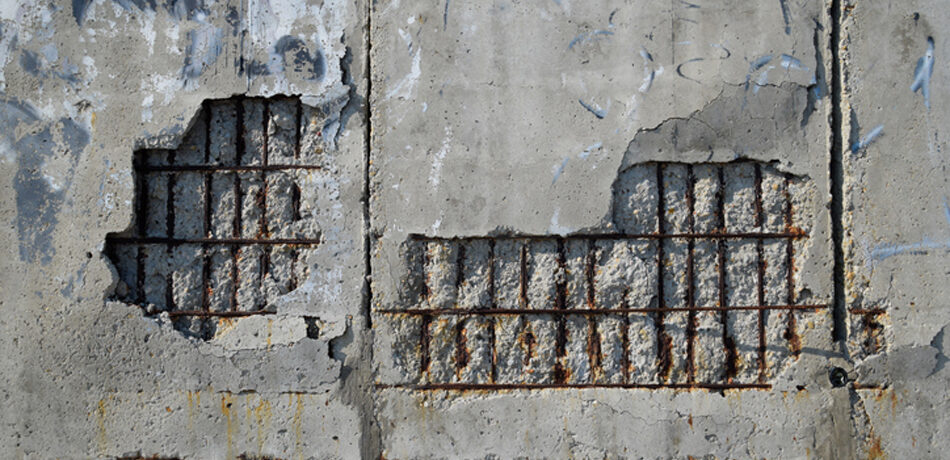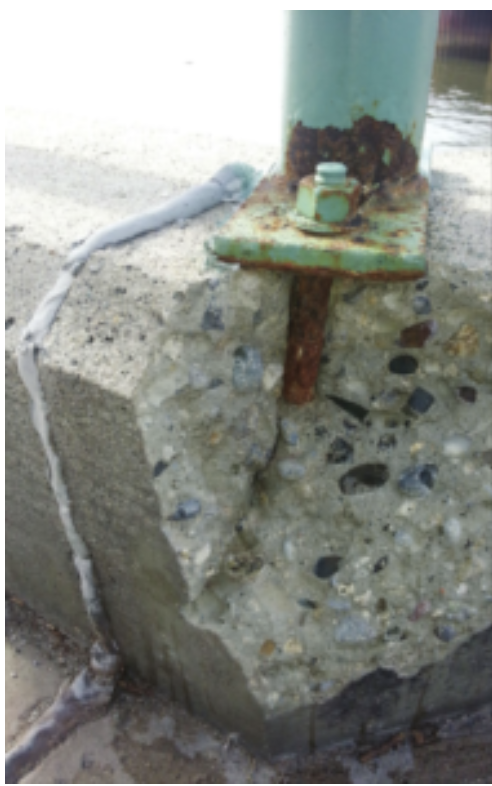Category
- Concrete Best Practices
Corrosion of reinforcing steel rebar in concrete is a pervasive issue, responsible for more concrete destruction than natural disasters or war. In fact, corrosion contributes to more than 80% of all damage in reinforced concrete structures.
Corrosion occurs over time due to a natural chemical or electrochemical reaction between the steel and its environment, leading to deterioration. The annual global cost of corrosion is estimated to exceed $1.8 trillion, underlining the economic impact of this silent, but destructive process.
Corrosion of rebar leads to the formation of rust, which has a greater volume than the original steel, causing internal stresses. This results in cracking, staining, and spalling of the concrete, severely compromising the structural integrity and safety of the affected structure.
Factors Contributing to Corrosion
When concrete is first poured, the high alkalinity initially forms a passive iron oxide film (Fe2O3) on the steel as it cures, protecting it from corrosion. However, while hardening, concrete also develops tiny pores. As water and corrosive agents penetrate these pores, they create microcracks that worsen over time.
Factors such as carbonation, chloride ingress, or environmental conditions accelerate the cracking, compromise the protective iron oxide layer, and lead to the eventual corrosion of rebar.
1. Carbonation
Atmospheric carbon dioxide penetrates concrete, lowering its pH and destabilizing the iron oxide layer on the steel. This process, known as carbonation, reduces the alkalinity of concrete, making it less capable of protecting the steel rebar. Over time, this leads to the initiation of corrosion, especially in environments with high CO2 concentrations.
2. Chloride Ingress
Chloride ions, from sources like de-icing salts and marine environments, are particularly aggressive. Chlorides penetrate concrete through cracks and porous structures, reaching the rebar and initiating corrosion. These ions disrupt the protective layer, leading to localized corrosion and pitting, which can be especially detrimental.
When the steel begins to rust and produce pits or holes in its surface, strength is reduced.
3. Environmental Conditions
Coastal regions and industrial areas with high humidity, salinity, and aggressive chemicals accelerate corrosion rates. For example, structures near the Gulf Coast experience high ambient temperatures and humidity levels, severe ground salinity, and sulfates in groundwater, all of which contribute to an aggressive corrosive environment.
Traditional Corrosion Prevention Methods
Several traditional methods are employed to mitigate rebar corrosion, though they have varying degrees of effectiveness:
1. Cathodic Protection
Cathodic protection is an expensive technique that converts active areas on the rebar surface to passive, making them the “cathode” of an electrochemical cell. There are two types: impressed current protection and galvanic protection. Impressed current protection uses an external power source to protect the metal and galvanic protection uses an artificial anode made of sacrificial metal that protects the original rebar.
2. Corrosion Inhibitor Admixture
Chemicals are added to the concrete mix to slow the corrosion process. They work by forming a protective film on the rebar or by chemically neutralizing corrosive agents. While effective in delaying the onset of corrosion, these inhibitors only provide temporary protection, especially in aggressive environments.
3. Anti-Corrosion Coatings
Anti-corrosion coatings like epoxy are applied to the rebar to prevent moisture and chlorides from reaching the steel. These coatings act as physical barriers, but can be prone to damage during construction or degradation over time. If the coating is compromised, localized corrosion can occur at a faster rate due to the small area exposed.
Despite their common usage, each of these three methods fall short in the long-term prevention of corrosion, leading to continuous maintenance and high lifecycle costs of concrete structures.
Advanced Corrosion Prevention Strategies
Modern advancements in concrete technology offer more effective solutions to prevent rebar corrosion. For example, integral crystalline waterproofing admixtures — like Krystol Internal Membrane (KIM) — are added directly to the concrete mix to reduce permeability and self-seal cracks.
These admixtures grow crystals that block the pathways for water and aggressive chemicals, enhancing durability and extending the lifespan of concrete structures. The crystalline technology reacts with water and unhydrated cement particles to form insoluble crystals within the concrete matrix, effectively — and permanently — blocking pores and microcracks.
- Crystallization occurs in the presence of water, lowering the permeability of the concrete
- The crystals reduce the size and quantity of cracks in the concrete
- Crystals continue to form, self-sealing new cracks that form later in the life of a structure
Concrete industry standards highlight integral crystalline waterproofing admixture as an advanced strategy to prevent corrosion, alongside other measures. For more details, visit the standards directly:
In particular, ACI 212 Chapter 15 focuses on Permeability-Reducing Admixtures, including integral admixtures like KIM, as key to enhancing concrete durability. These standards complement other measures found in:
- ACI PRC-222-19: Guide to Protection of Metals in Concrete Against Corrosion: This guide offers detailed methods and strategies to protect embedded metals in concrete from corrosion, focusing on the mechanisms and preventive measures.
- ACI PRC-201.2-23: Durable Concrete Guide describes specific types of concrete deterioration and the recommended requirements for individual components of concrete, quality considerations for concrete mixtures, construction procedures, and influences of the exposure environment.
- ACI PRC-224-01: Control of Cracking in Concrete Structures describes the principal causes and consequences of cracking and microcracking as well as recommended crack-control procedures
Best Practices for Corrosion Prevention
Preventing corrosion in reinforced concrete is crucial for maintaining the structural integrity, safety, and longevity of concrete structures. By combining traditional methods with modern advancements such as integral crystalline waterproofing admixtures, we can significantly reduce the incidence of rebar corrosion.
These strategies not only prolong the lifespan of concrete structures but also align with sustainable building practices by reducing maintenance costs and carbon-intensive resource consumption related to concrete repair and replacement.
Looking Ahead: Repair and Maintenance
Signs of cracking in existing concrete structures should not be ignored, and proper maintenance should be performed before corrosion sets in. Stay tuned for a future blog post that will highlight repair strategies, including the use of Kryton Leak Repair System, Krystol T1, and Hydrostop for infrastructure maintenance, ensuring longevity and durability in concrete structures.
For more information about protecting your rebar from corrosion, contact our team.




